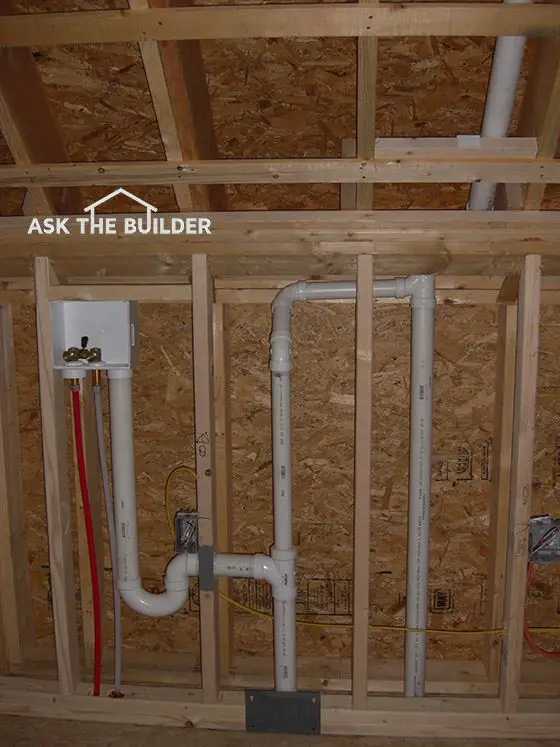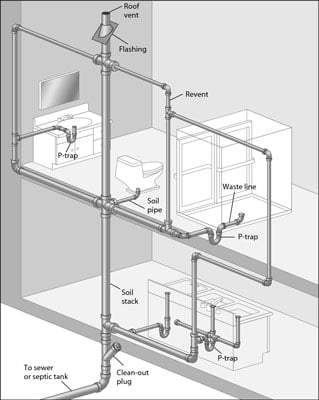Right here in the next paragraphs yow will discover a bunch of incredibly good tips related to What Are Plumbing Vents and Why Are They Important?.

Proper ventilation in plumbing systems is typically forgotten, yet it is important for maintaining the functionality and safety and security of your home's plumbing. Air flow helps manage atmospheric pressure, stop the accumulation of harmful gases, and make sure the reliable removal of waste. In this overview, we will check out the value of proper pipes air flow, just how it works, and the benefits it offers your plumbing system.
Comprehending Air Flow in Plumbing
Air flow in plumbing refers to the network of pipes that enable air to flow through the drain system. These vents offer numerous functions, consisting of regulating air pressure within the pipes, stopping sewage system gases from getting in the home, and assisting in the smooth circulation of wastewater.
Just How Ventilation Works in Pipes Equipments
Atmospheric Pressure Policy
Correct air flow preserves balanced air pressure within the pipes system. When water flows via pipelines, it displaces air. Without sufficient air flow, this displacement can develop adverse pressure, leading to slow down drains pipes or siphoning of water from catches, which can trigger undesirable odors to leak right into the home.
Stopping Drain Gas Accumulation
Among one of the most essential functions of pipes vents is to avoid drain gases, such as methane and hydrogen sulfide, from building up within the home. These gases can position serious health and wellness risks and are very flammable. Vent pipelines enable these gases to escape safely outdoors.
Assisting in Waste Removal
Air flow assists in the reliable elimination of wastewater by avoiding airlocks in the water drainage system. When air can flow freely with the vents, it enables water and waste to move smoothly through the pipes, lowering the risk of obstructions and back-ups.
Types of Pipes Vents
Key Heap Vent
The primary pile vent, additionally known as the air vent stack, is the main air vent in a pipes system. It expands from the primary drainpipe align via the roof covering, allowing gases to run away and fresh air to get in the system.
Branch Vent
Branch vents attach to the major pile air vent and serve specific fixtures, such as sinks, bathrooms, and showers. These vents make sure that each fixture has sufficient air flow to work appropriately.
Air Admittance Shutoff (AAV).
An Air Admission Valve (AAV) is a one-way shutoff that enables air to enter the plumbing system without the demand for a standard air vent pipeline prolonging through the roof. AAVs are frequently used in improvements or areas where mounting a typical vent is not practical.
Signs of Poor Air Flow in Pipes.
Slow Draining Fixtures.
If your sinks, bathtubs, or toilets are draining gradually, it could be an indication of bad air flow. Poor air circulation can create a vacuum cleaner effect, making it challenging for water to drain appropriately.
Gurgling Seems.
Gurgling noises coming from drains are commonly an outcome of air being drawn with water traps because of negative pressure in the pipelines. This is a clear indication of inadequate air flow.
Unpleasant Odors.
Drain odors inside your home are a red flag that your pipes system is not properly aerated. This could mean that sewage system gases are not being appropriately aired vent outside, resulting in possibly hazardous problems.
Typical Air Flow Errors.
Poor Vent Sizing.
Utilizing undersized air vent pipes can lead to bad air flow and stress discrepancies in the system. It's essential to utilize vents that fulfill the specific demands of your pipes system.
Improper Vent Placement.
Putting vents also much from the components they serve can decrease their performance. Appropriate placement makes sure that air can stream openly and efficiently via the system.
Disregarding Code Requirements.
Building regulations give specific guidelines for pipes ventilation. Ignoring these codes can lead to a system that stops working to function correctly and might bring about expensive repair work or health hazards.
Advantages of Correct Ventilation.
Enhanced System Effectiveness.
Correctly aerated plumbing systems operate a lot more efficiently, with less clogs, faster draining pipes, and much less stress on the pipelines. This efficiency expands the lifespan of the plumbing system.
Improved Air High Quality.
By avoiding sewage system gases from entering your home, appropriate air flow contributes to much better interior air quality, making your living atmosphere healthier and more comfy.
Stopping Water Damages.
Appropriate air flow helps protect against water from being siphoned out of traps, which can cause sewage system gases going into the home and triggering water damage gradually.
Actions to Make Certain Appropriate Air Flow.
Consulting Pipes Codes.
Always get in touch with neighborhood pipes codes when creating or changing your pipes system. These codes supply the needed guidelines for proper airing vent and guarantee your system meets safety and security criteria.
Routine Examination and Upkeep.
Routine evaluations can aid recognize possible air flow concerns prior to they come to be major problems. Upkeep jobs, such as cleaning vent pipelines and checking for blockages, are essential for maintaining the system in good working order.
Expert Installment.
For new installments or significant adjustments, it's a good idea to hire a professional plumbing technician. They have the experience to ensure the air flow system is appropriately created and mounted according to code.
Final thought.
Correct air flow is an essential part of any plumbing system, guaranteeing that it works effectively and safely. By recognizing the relevance of air flow, recognizing the indicators of bad air flow, and taking steps to maintain your system, you can prevent expensive issues and safeguard your home's air top quality.
4 Things You Should Know About Your Plumbing Vents
What Plumbing Vents Are
Also called a vent stack, a plumbing vent is a vertical pipe attached to your drain line that runs through your roof. The plumbing vent pipe, or plumbing air vent, removes gas and odors from your plumbing system and allows fresh air to enter the pipes, helping the water to flow out of the drain pipes.
What Plumbing Vents Do
Plumbing vents have two basic functions. One of which is to allow unpleasant smelling wastewater and sewer gasses to escape your plumbing system instead of entering your home. Plumbing vent pipes are typically located on roofs, away from windows, to ensure the fumes exit the home completely.
The other function of the plumbing vent is to move fresh air into your plumbing system. This helps move water through every plumbing fixture in your house, like toilets and sink drains. Think of the way in which you need to let a little air into the bottle as you pour soda in order to make the drink flow smoothly.
Different Types of Plumbing Vents
- True vent: This is the most common vent option. In simplest terms, a true vent is a vertical pipe attached to your drain line that exits through the roof. They often function as the main vent that other fixtures can connect to.
- Re-vent pipe or auxiliary vent: Attached to the drain line near specific plumbing fixtures, re-vent pipes run up and over to connect to the main vent.
- Common vent: Two plumbing fixtures installed on opposite sides of a wall are typically tied into the vent stack using something known as a sanitary cross.
- Wet vent: This venting option operates as a drain pipe and a vent at the same time. Wet vent drainage systems drain water from one fixture while venting the air from another. Although they’ve been used for over 100 years, wet vent systems have only recently been added to the plumbing code in many areas. If you’re planning on installing one in a bathroom remodel, make sure you check your local code prior to construction.
- Loop vent: For free-standing fixtures like kitchen island sinks, loop vents are ideal. These vent pipes run under the floor, rise from the P-trap, and create a loop inside the cabinet sink.
- Air admittance valve: An AAV is a one-way mechanical valve typically installed at the site of the plumbing fixture. AAVs allow venting to occur without having to tie into a larger venting system. They’re ideal for venting fixtures where you aren’t able to easily connect to an existing vent system.
Common Plumbing Vent Issues
Although vent pipes typically don’t have water flowing through them, they’re still subject to many typical plumbing issues. For example, clogs are one of the most common problems associated with sewer vent pipes. If your vent pipe gets clogged, all of your plumbing fixtures tied into the vent stack will be affected.
A sink with a slow drain that bubbles and gurgles or a strong sewage smell around your toilet are both indicators that your toilet vent pipe is clogged. Because most vent pipes exit through the roof, old leaves, twigs or even a bird’s nest could be clogging the pipe.
Clogs in your vent pipe system cause a buildup of negative pressure, meaning that water won’t be able to flow out of your home very well. It’s similar to putting your finger over the opening of a straw to trap water inside. When you remove your finger, the water is able to flow out of the straw.
If you suspect you have any blockage in your vent, make sure you have a professional come examine the situation. Left unchecked, a blocked air vent can lead to other costly repairs, like leaks and sediment buildup.
Under Pressure
Pipe vents are essential aspects of a home’s plumbing system. Owning a home means learning about all sorts of things you never put much thought into before. But by understanding as much as you can about the important systems of your home, you can keep those budgets intact and those anxiety levels low.
https://www.homeserve.com/en-us/blog/home-improvement/plumbing-vents/

I'm certainly very enthusiastic about What Are Plumbing Vents and Why Are They Important? and I really hope you liked our piece. For those who enjoyed reading our blog post if you please don't forget to pass it around. We cherish your readership.
Book Today!
Comments on “The Importance of Correct Ventilation in Your Plumbing System”